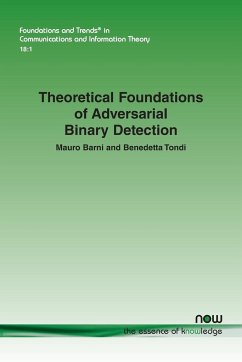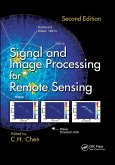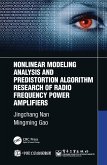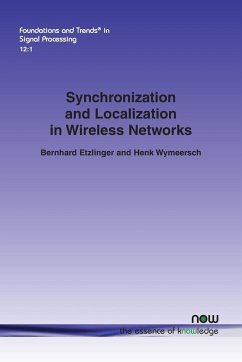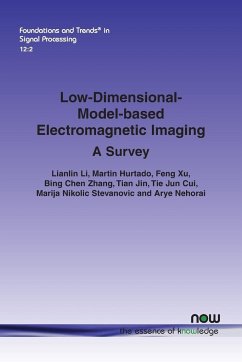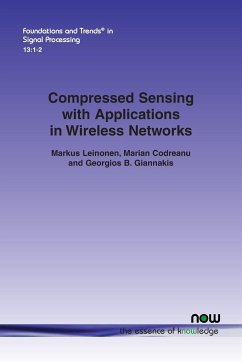Paul G Huray
The Foundations of Signal Integrity
Paul G Huray
The Foundations of Signal Integrity
- Broschiertes Buch
Andere Kunden interessierten sich auch für
![Theoretical Foundations of Adversarial Binary Detection Theoretical Foundations of Adversarial Binary Detection]() Mauro BarniTheoretical Foundations of Adversarial Binary Detection101,99 €
Mauro BarniTheoretical Foundations of Adversarial Binary Detection101,99 €![Digital Signal Processing Digital Signal Processing]() João Marques de CarvalhoDigital Signal Processing35,99 €
João Marques de CarvalhoDigital Signal Processing35,99 €![Signal and Image Processing for Remote Sensing Signal and Image Processing for Remote Sensing]() C H ChenSignal and Image Processing for Remote Sensing102,99 €
C H ChenSignal and Image Processing for Remote Sensing102,99 €![Nonlinear Modeling Analysis and Predistortion Algorithm Research of Radio Frequency Power Amplifiers Nonlinear Modeling Analysis and Predistortion Algorithm Research of Radio Frequency Power Amplifiers]() Jingchang NanNonlinear Modeling Analysis and Predistortion Algorithm Research of Radio Frequency Power Amplifiers65,99 €
Jingchang NanNonlinear Modeling Analysis and Predistortion Algorithm Research of Radio Frequency Power Amplifiers65,99 €![Synchronization and Localization in Wireless Networks Synchronization and Localization in Wireless Networks]() Bernhard EtzlingerSynchronization and Localization in Wireless Networks81,99 €
Bernhard EtzlingerSynchronization and Localization in Wireless Networks81,99 €![Low-Dimensional-Model-based Electromagnetic Imaging Low-Dimensional-Model-based Electromagnetic Imaging]() Lianlin LiLow-Dimensional-Model-based Electromagnetic Imaging74,99 €
Lianlin LiLow-Dimensional-Model-based Electromagnetic Imaging74,99 €![Compressed Sensing with Applications in Wireless Networks Compressed Sensing with Applications in Wireless Networks]() Markus LeinonenCompressed Sensing with Applications in Wireless Networks101,99 €
Markus LeinonenCompressed Sensing with Applications in Wireless Networks101,99 €-
-
-
Produktdetails
- Verlag: John Wiley & Sons
- Erscheinungstermin: 7. Januar 2010
- Englisch
- Abmessung: 244mm x 160mm x 43mm
- Gewicht: 1202g
- ISBN-13: 9780470891582
- ISBN-10: 0470891580
- Artikelnr.: 33608777
Hinweis: Dieser Artikel kann nur an eine deutsche Lieferadresse ausgeliefert werden.
- Herstellerkennzeichnung
- Libri GmbH
- Europaallee 1
- 36244 Bad Hersfeld
- gpsr@libri.de
Paul G. Huray, PhD, is Professor of Electrical Engineering at the University of South Carolina, where he has taught signal integrity, mathematical physics, and computer communications. Professor Huray introduced the first electromagnetics course to focus on signal integrity, and that program has produced more than eighty practicing signal integrity engineers now employed in academia, industry, and government. He earned his PhD in physics at the University of Tennessee in 1968, conducted research in the Solid State, Chemistry, and Physics Divisions at the Oak Ridge National Laboratory, and has worked part time for the Intel Corporation in developing the physical basis for barriers to circuits with bit rates up to 100 GHz.
Preface.
Intent of the Book.
1. Plane Electromagnetic Waves.
Introduction.
1.1 Propagating Plane Waves.
1.2 Polarized Plane Waves.
1.3 Doppler Shift.
1.4 Plane Waves in a Lossy Medium.
1.5 Dispersion and Group Velocity.
1.6 Power and Energy Propagation.
1.7 Momentum Propagation.
Endnotes.
2. Plane Waves in Compound Media.
Introduction.
2.1 Plane Wave Propagating in a Material as It Orthogonally Interacts with
a Second Material.
2.2 Electromagnetic Boundary Conditions.
2.3 Plane Wave Propagating in a Material as It Orthogonally Interacts with
Two Boundaries.
2.4 Plane Wave Propagating in a Material as It Orthogonally Interacts with
Multiple Boundaries.
2.5 Polarized Plane Waves Propagating in a Material as They Interact
Obliquely with a Boundary.
2.6 Brewster's Law.
2.7 Applications of Snell's Law and Brewster's Law.
Endnote.
3. Transmission Lines and Waveguides.
3.1 Infi nitely Long Transmission Lines.
3.2 Governing Equations.
3.3 Special Cases.
3.4 Power Transmission.
3.5 Finite Transmission Lines.
3.6 Harmonic Waves in Finite Transmission Lines.
3.7 Using AC Spice Models.
3.8 Transient Waves in Finite Transmission Lines.
4. Ideal Models vs Real-World Systems.
Introduction.
4.1 Ideal Transmission Lines.
4.2 Ideal Model Transmission Line Input and Output.
4.3 Real-World Transmission Lines.
4.4 Effects of Surface Roughness.
4.5 Effects of the Propagating Material.
4.6 Effects of Grain Boundaries.
4.7 Effects of Permeability.
4.8 Effects of Board Complexity.
4.9 Final Conclusions for an Ideal versus a Real-World Transmission Line.
Endnotes.
5. Complex Permittivity of Propagating Media.
Introduction.
5.1 Basic Mechanisms of the Propagating Material.
5.2 Permittivity of Permanent Polar Molecules.
5.3 Induced Dipole Moments.
5.4 Induced Dipole Response Function, G(¿).
5.5 Frequency Character of the Permittivity.
5.6 Kramers-Kronig Relations for Induced Moments.
5.7 Arbitrary Time Stimulus.
5.8 Conduction Electron Permittivity.
5.9 Conductivity Response Function.
5.10 Permittivity of Plasma Oscillations.
5.11 Permittivity Summary.
5.12 Empirical Permittivity.
5.13 Theory Applied to Empirical Permittivity.
5.14 Dispersion of a Signal Propagating through a Medium with Complex
Permittivity.
Endnotes.
6. Surface Roughness.
Introduction.
6.1 Snowball Model for Surface Roughness.
6.2 Perfect Electric Conductors in Static Fields.
6.3 Spherical Conductors in Time-Varying Fields.
6.4 The Far-Field Region.
6.5 Electrodynamics in Good Conducting Spheres.
6.6 Spherical Coordinate Analysis.
6.7 Vector Helmholtz Equation Solutions.
6.8 Multipole Moment Analysis.
6.9 Scattering of Electromagnetic Waves.
6.10 Power Scattered and Absorbed by Good Conducting Spheres.
6.11 Applications of Fundamental Scattering.
Endnotes.
7. Advanced Signal Integrity.
Introduction.
7.1 Induced Surface Charges and Currents.
7.2 Reduced Magnetic Dipole Moment Due to Field Penetration.
7.3 Infl uence of a Surface Alloy Distribution.
7.4 Screening of Neighboring Snowballs and Form Factors.
7.5 Pulse Phase Delay and Signal Dispersion.
Chapter Conclusions.
Endnotes.
8. Signal Integrity Simulations.
Introduction.
8.1 Defi nition of Terms and Techniques.
8.2 Circuit Simulation.
8.3 Transient SPICE Simulation.
8.4 Emerging SPICE Simulation Methods.
8.5 Fast Convolution Analysis.
8.6 Quasi-Static Field Solvers.
8.7 Full-Wave 3-D FEM Field Solvers.
8.8 Conclusions.
Endnotes.
Bibliography.
Index.
Intent of the Book.
1. Plane Electromagnetic Waves.
Introduction.
1.1 Propagating Plane Waves.
1.2 Polarized Plane Waves.
1.3 Doppler Shift.
1.4 Plane Waves in a Lossy Medium.
1.5 Dispersion and Group Velocity.
1.6 Power and Energy Propagation.
1.7 Momentum Propagation.
Endnotes.
2. Plane Waves in Compound Media.
Introduction.
2.1 Plane Wave Propagating in a Material as It Orthogonally Interacts with
a Second Material.
2.2 Electromagnetic Boundary Conditions.
2.3 Plane Wave Propagating in a Material as It Orthogonally Interacts with
Two Boundaries.
2.4 Plane Wave Propagating in a Material as It Orthogonally Interacts with
Multiple Boundaries.
2.5 Polarized Plane Waves Propagating in a Material as They Interact
Obliquely with a Boundary.
2.6 Brewster's Law.
2.7 Applications of Snell's Law and Brewster's Law.
Endnote.
3. Transmission Lines and Waveguides.
3.1 Infi nitely Long Transmission Lines.
3.2 Governing Equations.
3.3 Special Cases.
3.4 Power Transmission.
3.5 Finite Transmission Lines.
3.6 Harmonic Waves in Finite Transmission Lines.
3.7 Using AC Spice Models.
3.8 Transient Waves in Finite Transmission Lines.
4. Ideal Models vs Real-World Systems.
Introduction.
4.1 Ideal Transmission Lines.
4.2 Ideal Model Transmission Line Input and Output.
4.3 Real-World Transmission Lines.
4.4 Effects of Surface Roughness.
4.5 Effects of the Propagating Material.
4.6 Effects of Grain Boundaries.
4.7 Effects of Permeability.
4.8 Effects of Board Complexity.
4.9 Final Conclusions for an Ideal versus a Real-World Transmission Line.
Endnotes.
5. Complex Permittivity of Propagating Media.
Introduction.
5.1 Basic Mechanisms of the Propagating Material.
5.2 Permittivity of Permanent Polar Molecules.
5.3 Induced Dipole Moments.
5.4 Induced Dipole Response Function, G(¿).
5.5 Frequency Character of the Permittivity.
5.6 Kramers-Kronig Relations for Induced Moments.
5.7 Arbitrary Time Stimulus.
5.8 Conduction Electron Permittivity.
5.9 Conductivity Response Function.
5.10 Permittivity of Plasma Oscillations.
5.11 Permittivity Summary.
5.12 Empirical Permittivity.
5.13 Theory Applied to Empirical Permittivity.
5.14 Dispersion of a Signal Propagating through a Medium with Complex
Permittivity.
Endnotes.
6. Surface Roughness.
Introduction.
6.1 Snowball Model for Surface Roughness.
6.2 Perfect Electric Conductors in Static Fields.
6.3 Spherical Conductors in Time-Varying Fields.
6.4 The Far-Field Region.
6.5 Electrodynamics in Good Conducting Spheres.
6.6 Spherical Coordinate Analysis.
6.7 Vector Helmholtz Equation Solutions.
6.8 Multipole Moment Analysis.
6.9 Scattering of Electromagnetic Waves.
6.10 Power Scattered and Absorbed by Good Conducting Spheres.
6.11 Applications of Fundamental Scattering.
Endnotes.
7. Advanced Signal Integrity.
Introduction.
7.1 Induced Surface Charges and Currents.
7.2 Reduced Magnetic Dipole Moment Due to Field Penetration.
7.3 Infl uence of a Surface Alloy Distribution.
7.4 Screening of Neighboring Snowballs and Form Factors.
7.5 Pulse Phase Delay and Signal Dispersion.
Chapter Conclusions.
Endnotes.
8. Signal Integrity Simulations.
Introduction.
8.1 Defi nition of Terms and Techniques.
8.2 Circuit Simulation.
8.3 Transient SPICE Simulation.
8.4 Emerging SPICE Simulation Methods.
8.5 Fast Convolution Analysis.
8.6 Quasi-Static Field Solvers.
8.7 Full-Wave 3-D FEM Field Solvers.
8.8 Conclusions.
Endnotes.
Bibliography.
Index.
Preface.
Intent of the Book.
1. Plane Electromagnetic Waves.
Introduction.
1.1 Propagating Plane Waves.
1.2 Polarized Plane Waves.
1.3 Doppler Shift.
1.4 Plane Waves in a Lossy Medium.
1.5 Dispersion and Group Velocity.
1.6 Power and Energy Propagation.
1.7 Momentum Propagation.
Endnotes.
2. Plane Waves in Compound Media.
Introduction.
2.1 Plane Wave Propagating in a Material as It Orthogonally Interacts with
a Second Material.
2.2 Electromagnetic Boundary Conditions.
2.3 Plane Wave Propagating in a Material as It Orthogonally Interacts with
Two Boundaries.
2.4 Plane Wave Propagating in a Material as It Orthogonally Interacts with
Multiple Boundaries.
2.5 Polarized Plane Waves Propagating in a Material as They Interact
Obliquely with a Boundary.
2.6 Brewster's Law.
2.7 Applications of Snell's Law and Brewster's Law.
Endnote.
3. Transmission Lines and Waveguides.
3.1 Infi nitely Long Transmission Lines.
3.2 Governing Equations.
3.3 Special Cases.
3.4 Power Transmission.
3.5 Finite Transmission Lines.
3.6 Harmonic Waves in Finite Transmission Lines.
3.7 Using AC Spice Models.
3.8 Transient Waves in Finite Transmission Lines.
4. Ideal Models vs Real-World Systems.
Introduction.
4.1 Ideal Transmission Lines.
4.2 Ideal Model Transmission Line Input and Output.
4.3 Real-World Transmission Lines.
4.4 Effects of Surface Roughness.
4.5 Effects of the Propagating Material.
4.6 Effects of Grain Boundaries.
4.7 Effects of Permeability.
4.8 Effects of Board Complexity.
4.9 Final Conclusions for an Ideal versus a Real-World Transmission Line.
Endnotes.
5. Complex Permittivity of Propagating Media.
Introduction.
5.1 Basic Mechanisms of the Propagating Material.
5.2 Permittivity of Permanent Polar Molecules.
5.3 Induced Dipole Moments.
5.4 Induced Dipole Response Function, G(¿).
5.5 Frequency Character of the Permittivity.
5.6 Kramers-Kronig Relations for Induced Moments.
5.7 Arbitrary Time Stimulus.
5.8 Conduction Electron Permittivity.
5.9 Conductivity Response Function.
5.10 Permittivity of Plasma Oscillations.
5.11 Permittivity Summary.
5.12 Empirical Permittivity.
5.13 Theory Applied to Empirical Permittivity.
5.14 Dispersion of a Signal Propagating through a Medium with Complex
Permittivity.
Endnotes.
6. Surface Roughness.
Introduction.
6.1 Snowball Model for Surface Roughness.
6.2 Perfect Electric Conductors in Static Fields.
6.3 Spherical Conductors in Time-Varying Fields.
6.4 The Far-Field Region.
6.5 Electrodynamics in Good Conducting Spheres.
6.6 Spherical Coordinate Analysis.
6.7 Vector Helmholtz Equation Solutions.
6.8 Multipole Moment Analysis.
6.9 Scattering of Electromagnetic Waves.
6.10 Power Scattered and Absorbed by Good Conducting Spheres.
6.11 Applications of Fundamental Scattering.
Endnotes.
7. Advanced Signal Integrity.
Introduction.
7.1 Induced Surface Charges and Currents.
7.2 Reduced Magnetic Dipole Moment Due to Field Penetration.
7.3 Infl uence of a Surface Alloy Distribution.
7.4 Screening of Neighboring Snowballs and Form Factors.
7.5 Pulse Phase Delay and Signal Dispersion.
Chapter Conclusions.
Endnotes.
8. Signal Integrity Simulations.
Introduction.
8.1 Defi nition of Terms and Techniques.
8.2 Circuit Simulation.
8.3 Transient SPICE Simulation.
8.4 Emerging SPICE Simulation Methods.
8.5 Fast Convolution Analysis.
8.6 Quasi-Static Field Solvers.
8.7 Full-Wave 3-D FEM Field Solvers.
8.8 Conclusions.
Endnotes.
Bibliography.
Index.
Intent of the Book.
1. Plane Electromagnetic Waves.
Introduction.
1.1 Propagating Plane Waves.
1.2 Polarized Plane Waves.
1.3 Doppler Shift.
1.4 Plane Waves in a Lossy Medium.
1.5 Dispersion and Group Velocity.
1.6 Power and Energy Propagation.
1.7 Momentum Propagation.
Endnotes.
2. Plane Waves in Compound Media.
Introduction.
2.1 Plane Wave Propagating in a Material as It Orthogonally Interacts with
a Second Material.
2.2 Electromagnetic Boundary Conditions.
2.3 Plane Wave Propagating in a Material as It Orthogonally Interacts with
Two Boundaries.
2.4 Plane Wave Propagating in a Material as It Orthogonally Interacts with
Multiple Boundaries.
2.5 Polarized Plane Waves Propagating in a Material as They Interact
Obliquely with a Boundary.
2.6 Brewster's Law.
2.7 Applications of Snell's Law and Brewster's Law.
Endnote.
3. Transmission Lines and Waveguides.
3.1 Infi nitely Long Transmission Lines.
3.2 Governing Equations.
3.3 Special Cases.
3.4 Power Transmission.
3.5 Finite Transmission Lines.
3.6 Harmonic Waves in Finite Transmission Lines.
3.7 Using AC Spice Models.
3.8 Transient Waves in Finite Transmission Lines.
4. Ideal Models vs Real-World Systems.
Introduction.
4.1 Ideal Transmission Lines.
4.2 Ideal Model Transmission Line Input and Output.
4.3 Real-World Transmission Lines.
4.4 Effects of Surface Roughness.
4.5 Effects of the Propagating Material.
4.6 Effects of Grain Boundaries.
4.7 Effects of Permeability.
4.8 Effects of Board Complexity.
4.9 Final Conclusions for an Ideal versus a Real-World Transmission Line.
Endnotes.
5. Complex Permittivity of Propagating Media.
Introduction.
5.1 Basic Mechanisms of the Propagating Material.
5.2 Permittivity of Permanent Polar Molecules.
5.3 Induced Dipole Moments.
5.4 Induced Dipole Response Function, G(¿).
5.5 Frequency Character of the Permittivity.
5.6 Kramers-Kronig Relations for Induced Moments.
5.7 Arbitrary Time Stimulus.
5.8 Conduction Electron Permittivity.
5.9 Conductivity Response Function.
5.10 Permittivity of Plasma Oscillations.
5.11 Permittivity Summary.
5.12 Empirical Permittivity.
5.13 Theory Applied to Empirical Permittivity.
5.14 Dispersion of a Signal Propagating through a Medium with Complex
Permittivity.
Endnotes.
6. Surface Roughness.
Introduction.
6.1 Snowball Model for Surface Roughness.
6.2 Perfect Electric Conductors in Static Fields.
6.3 Spherical Conductors in Time-Varying Fields.
6.4 The Far-Field Region.
6.5 Electrodynamics in Good Conducting Spheres.
6.6 Spherical Coordinate Analysis.
6.7 Vector Helmholtz Equation Solutions.
6.8 Multipole Moment Analysis.
6.9 Scattering of Electromagnetic Waves.
6.10 Power Scattered and Absorbed by Good Conducting Spheres.
6.11 Applications of Fundamental Scattering.
Endnotes.
7. Advanced Signal Integrity.
Introduction.
7.1 Induced Surface Charges and Currents.
7.2 Reduced Magnetic Dipole Moment Due to Field Penetration.
7.3 Infl uence of a Surface Alloy Distribution.
7.4 Screening of Neighboring Snowballs and Form Factors.
7.5 Pulse Phase Delay and Signal Dispersion.
Chapter Conclusions.
Endnotes.
8. Signal Integrity Simulations.
Introduction.
8.1 Defi nition of Terms and Techniques.
8.2 Circuit Simulation.
8.3 Transient SPICE Simulation.
8.4 Emerging SPICE Simulation Methods.
8.5 Fast Convolution Analysis.
8.6 Quasi-Static Field Solvers.
8.7 Full-Wave 3-D FEM Field Solvers.
8.8 Conclusions.
Endnotes.
Bibliography.
Index.


